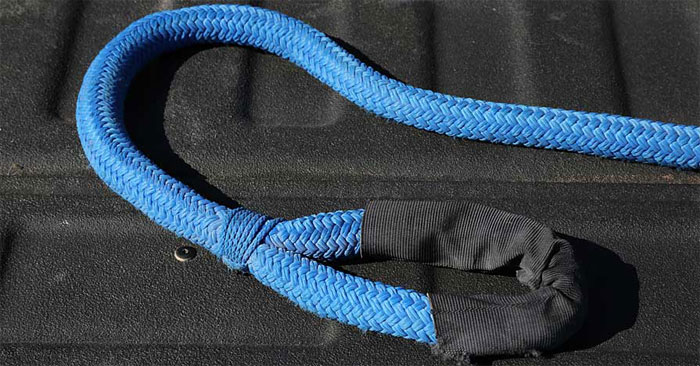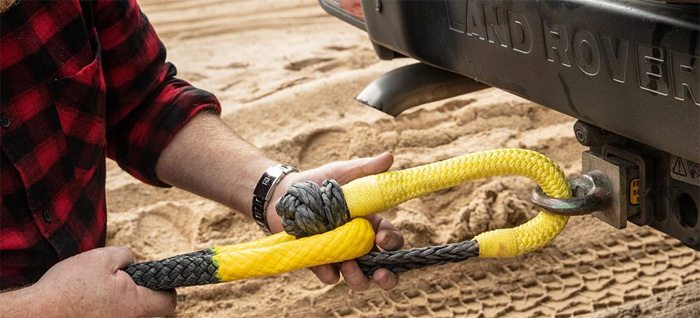How Does a Kinetic Tow Rope Work?
by Chris Lewis.
You might have already heard about kinetic ropes. They are one of the essentials for offroad driving. Without them, you will not be able to have that peace-of-mind in your offroading adventures. That is why people always check whether they have one of these in the trunk's back or not before heading out on an offroading adventure.
Now, if you have heard about them and do not have one for yourself, you might be wondering how a kinetic tow rope works.
Well, it is quite important to know the operational mechanism of these before attempting to use these straps. Alongside that, you should also know how to use one of these before you buy one for yourself.
And we are here to fill you in on both of the matters that we have mentioned above. Hopefully, by the end, you will not only know how to use these but also will know how they actually function. With that said, let us dive right into it, shall we?
Contents
What Exactly Are Kinetic Ropes?

Before anything else, we want to make sure that you actually know what exactly kinetic ropes are instead of guessing that you might already know about them. In short, these offer you a safer way to recover your stuck vehicles from uncomfortable situations.
Now, you might ask what exactly are the awkward situations that we are implying here. They are as follows:
Muddy Tracks
Well, to begin with, muddy tracks are quite common for offroad terrains. And in muddy tracks, there is a high possibility of your vehicle getting stuck as the tire can sometimes not get enough traction to move forward.
If the tire does not get enough traction, no matter how hard you push the accelerator, you will not be able to tread one inch.
Rocky Terrains
Besides that, rocky terrains is another common thing that you are going to stumble upon in offroad terrains. And regardless of how much treading your tire has, there will be some bumpy and rocky roads where you will find yourself stuck between two large-sized rocks.
Submerged Terrains
Lastly, you might have to pass through a lot of lakes and small-sized ponds in your adventure. Most of these water bodies will have quicksands. And there remains a high possibility of you getting stuck while trying to pass through these water bodies.
Aside from the ones that we have mentioned above, there might be some other situations where you will find it difficult to move your four-wheeler. And that is where these straps are going to come into play.
How Does Kinetic Rope Work?

The basic principle behind how kinetic ropes function is almost the same as the traditional snatch straps. Just like those, you would require a set of vehicles. One of them is stuck, and the other one will carry out the recovery process.
However, there is a major difference between the traditional straps and the kinetic straps. As the name suggests, kinetic straps are stretchy. Most of them can even stretch up to 30% of their original length.
As a result, the vehicles will not face any sort of shocks during load, which is quite common while performing the recovery using traditional straps.
Wonder what the actual benefits of having a less amount of shock during recovery are? Well, the most obvious one would be that there would be a less amount of strap on the recovery equipment. As a result, the possibility of them snapping would be pretty low.
Alongside that, there would be a less amount of stress on the vehicles too. As a result, you would not have to accelerate that much during the process.
How to Use a Kinetic Recovery Rope?
Now, if you want to fully understand how these actually work, you need to know how to use one of these. And the steps are as follows:
Step 1: Verify Whether Your Equipment Is Adequate for the Operation or Not
First of all, you need to check whether the equipment that you are using is right for the recovery task or not. There are plenty of sizes for these ropes, and not all of them will be ideal for all types of vehicles that are out there.
We are going to provide a size list on the next segment if you do not have any idea about the sizing and the adequate amount of load that they can take.
Step 2: Make the Recovery Path Clear
One thing that you have to keep in mind after you have checked that you have the right rope or not is the recovery path.
You can only recover a stuck vehicle by pulling it forward or backward. Pushing or pulling from sideways will not get your stuck vehicle anywhere away from the stuck area.
Now that you know the directions, you will have the clear the path. If you are planning to pull the stuck vehicle backward, make sure that there are no obstructions on the way.
Remove any large-sized objects that you are able to pick up by yourself. The principle is the same if you are planning to pull it forward.
Step 3: Attach the Rope on Both the Vehicle
After you have cleared the recovery path, you need to attach the equipment to both vehicles. It is advised not to attach the rope with a tow ball because they are not really designed to carry out the load that is required for recovering vehicles. Instead, you will have to put the rope in a tow point or a shackle.
Step 4: Ensure That the Recovery Area Is Clear
Now that you have connected the ropes, you should make sure that there are no people around the area. Only the driver in the recovery vehicle and the vehicle that is carrying out the process should be within the 1.5x rope length area.
As there remains a chance of these snapping, people residing in that certain area can be injured if that unfortunate event does occur.
Step 5: Accelerate Both the Vehicles
Once you have cleared all the obstruction, you have to press the accelerator on both the vehicles. Do make sure that you are not exceeding 5 MPH for the one that is commencing the recovery process.
You can push the accelerator as hard as you can for the stuck vehicle but not for the one that is pulling the stuck vehicle.
Step 6: Remove the Equipment
Once you have successfully taken the stuck vehicle out from the place, you should remove all the equipment and store them properly inside your vehicle.
The Sizes
As we have mentioned above, we will provide you with knowledge about the sizes and the load they can carry. They are as follows:
- ½ inches: 7400 pounds
- ¾ inches: 19000 pounds
- 7/8 inches: 28300 pounds
- 1 inch: 33500 pounds
- 1-1/4 inches: 52300 pounds
- 1-1/2 inches: 74000 pounds
- 2 inches: 131500 pounds
- 2-1/4 inches: 18100 pounds
- 2-1/2 inches: 201000 pounds
Conclusion

To sum things up, we hope that we were able to let you know how a kinetic tow rope works. That being said, we would want to wish you a dash of good luck and hope that you can properly carry out the recovery process with the rope that you have or plan to buy.
 |
 |
 |
 |

About Chris Lewis.
Chris Lewis is a passionate individual with a deep affinity for the world of automobiles. From a tender age, his fascination with cars was nurtured by his father, a seasoned mechanic based in the vibrant city of San Francisco. Growing up under the watchful guidance of his skilled father, Chris developed an early aptitude for all things automotive.
Thoughts on "How Does a Kinetic Tow Rope Work?"
 |
 |
 |
 |
Get FREE Filters now. Or latest free tools from our best collections.
Disable Ad block to get all the secrets. Once done, hit any button below
 |
 |
 |
 |